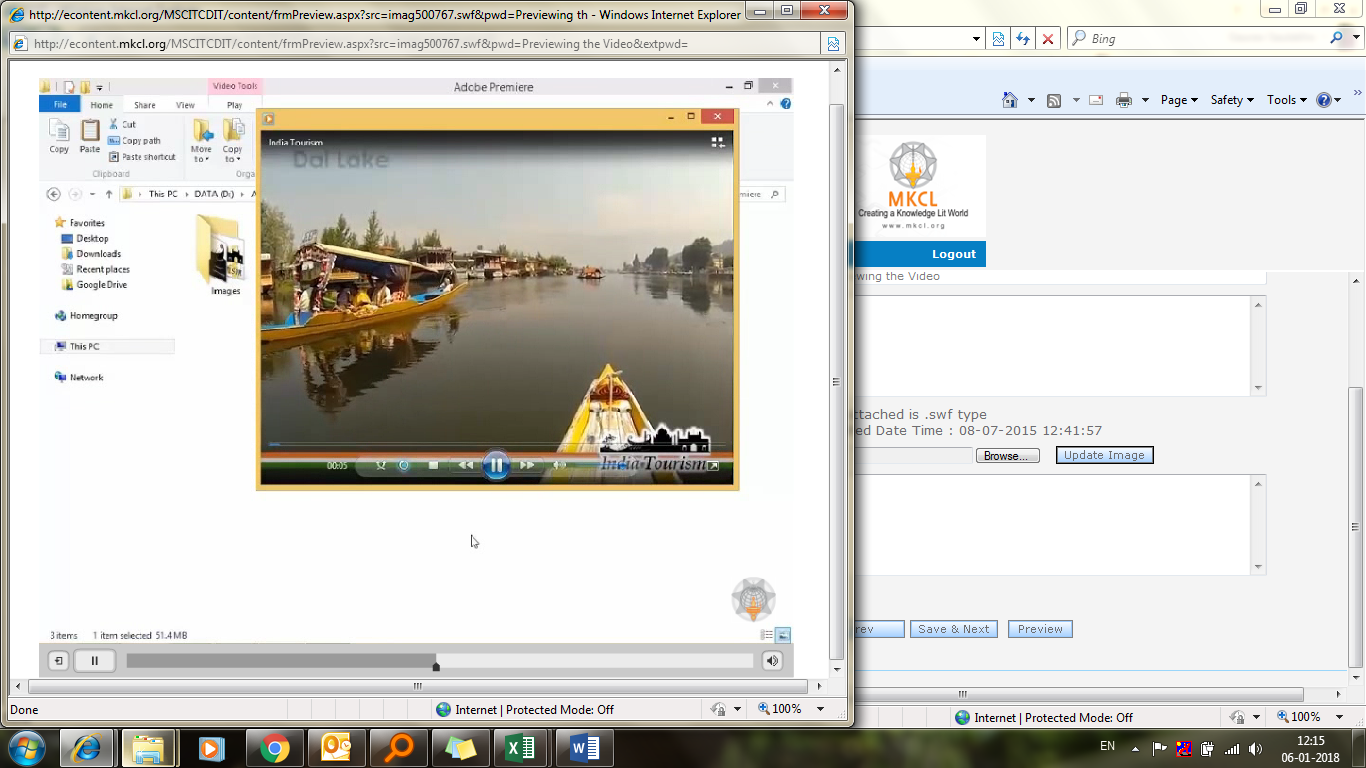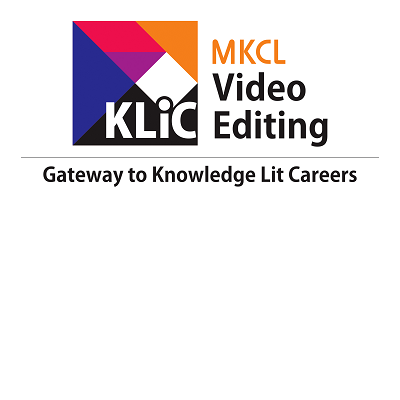About the Course
Today, we can find video as media in various fields such as education, entertainment, advertising and marketing, business, games, communication and list may go on and on. Day by day, the presence of video media is increasing on the web along with film and television. YouTube is a great example of web video streaming.
Editing is an important element of the video creation process. It is an art of storytelling; it is a process of modifying or re-arranging the segments of video from one or more video tapes to create a final piece of video. The major task of video editor includes editing of soundtracks, video and film for the motion picture and broadcast visual media industries.
Course Details
After completing this course, the student will be able to perform following roles:
Career Opportunities (Industry wise): -
- Television Studio
- Film Studio
- Advertising studio
- Multimedia companies
- eLearning companies
- Web-Designing companies
- Career Paths:
Television & Film Editor
- Video Editor
- Assistant Video Editor
- Film Compositor
- VFX Compositor
Hence, various career opportunities gets opened up for students.
Certification:
- KLiC courses are recognised by Yashwantrao Chavan Maharashtra Open University (YCMOU).
- MKCL provides certificate to the KLiC learner after his/her successful course completion.
- Yashwantrao Chavan Maharashtra Open University (YCMOU) provides mark sheet to successfully passed KLiC learners (Jurisdiction: Maharashtra).
Important Dates:
- Batch Commencement: One batch in each calendar month (January to December)
- Date(s) of Application and Fee Payment by Learner: 1st - 30th day of each calendar month
- Date(s) of Learner Confirmation by ALC: 1st - 30th day of each calendar month
- Course Start Date and Date of Issuing Learner Login: Date of admission confirmation
The Academic Approach of the course focuses on the work centric education i.e. begin with work (and not from a book !), derive knowledge from work and apply that knowledge to make the work more wholesome, useful and delightful. The ultimate objective is to empower the Learner to engage in socially useful and productive work. It aims at leading the learner to his/her rewarding career as well as development of the society.<
Learning methodology
- Learners are given an overview of the course and its connection to life and work.
- Learners are then exposed to the specific tool(s) used in the course through the various real-life applications of the tool(s).
- Learners are then acquainted with the careers and the hierarchy of roles they can perform at workplaces after attaining increasing levels of mastery over the tool(s).
- Learners are then acquainted with the architecture of the tool or Tool Map so as to appreciate various parts of the tool, their functions and their inter-relations.
- Learners are then exposed to simple application development methodology by using the tool at the beginners level
- Learners then perform the differential skills related to the use of the tool to improve the given ready-made outputs.
- Learners are then engaged in appreciation of real-life case studies developed by the experts.
- Learners are then encouraged to proceed from appreciation to imitation of the experts.
- After imitation experience, they are required to improve the experts outputs so that they proceed from mere imitation to emulation.
- Finally, they develop the integral skills involving optimal methods and best practices to produce useful outputs right from scratch, publish them in their ePortfolio and thereby proceed from emulation to self-expression.
Skills: Importing and Capturing Footage, Timeline, Sequence and Clip Management, Basic Video Editing, Editing Audio, Mixing and Creating Effects with the Audio Mixer, Creating Transitions, Creating Titles and Graphics, Working with advanced editing techniques, Using Video Effects, Using Color mattes and Backdrops, Enhancing Video, Wrapping Up and Exporting
Outputs: Video Merging, Advertisement creation, video effects, Creating a Short Film
Creating Short Film

Detailed Syllabus:
KLiC Video Editing
Introduction to Video Editing with Premiere CS4
- Overview of Video Editing
- Uses of Premiere Pro CS4
- Features of Premiere CS4
- Installing Premiere Pro CS4
Introduction to Moviemaking
Introduction to GST
- Basics of digital video and movie editing
- Comparing camcorder formats
- Understanding video codecs
- Shooting better video
Getting Started with Premiere Pro CS4
- Working with workspace
- Customizing the Workspace in Premiere Pro CS4
- Working with project settings
- Importing files as footage
- Importing stills
- Importing layered Photoshop and Illustrator files
- Dealing with missing media
- Setting up to capture from tape
- Logging Tapes
- Batch-capturing footage
- Timeline
- Using Multiple Sequences
- Clip Project Management
- Basic Editing Concept and Tools
- Working with Monitor Panels
- Creating Insert and Overlay Edits
- Editing in the Timeline
- Setting In and Out Points in the Timeline Panel
- What is Audio?
- Timeline Audio Tracks
- Editing Audi
- Recording Audio
- Gaining, Fading and Balancing
- Using Audio Effects and Transitions
- Audio Mixer Overview
- Setting Track Volume & Mixing Tracks
- Panning & Balancing
- Applying effects with Audio Mixer
- About Video Transitions (Overview)
- Applying transitions
- Adjusting Transitions
- Customizing Transitions
- Various Transitions Effects
- Using the Titler
- Creating titles from templates
- Modifying a title
- Creating titles from scratch
- Superimposing a title
- Creating a title roll or crawl
- Editing Utilities
- Editing with tool panel tools
- Fine tuning edits using the trim monitor panel
- Editing a Clip Using Clip Commands
- Exploring the Video Effects
- Applying a Video Effect
- Using Video Effects with Keyframes
- Superimposing Video Clip Using Keying Video Effect
- Applying effects using Image Matte Keying Effects
- Touring Premiere Pro Video Effects
- Mattes, Transparency and Opacity
- Create transparency, solid colors with keys mattes
- Matte other than the alpha channel
- Using more mattes
- Motion effect controls in Effect Controls Panel
- Working with the Motion Controls
- Using timeline Panel to Preview & add Keyframes
- Editing Motion Paths
- Adding Effects to Motion Paths
- Using a clip with an Alpha Channel
- Creating Traveling Mattes
- Understanding video color
- Color Correcting Basics
- Start a Color Correcting Session
- Using the Video Scopes
- Color Enhancement Effects
- Special color and luminance adjustments
- Retouch Using Photoshop and After Effects
- Preparing to export video
- Exporting to tape
- Exporting to Encore DVD
- Exporting to various formats using Adobe Encoder
- Sharing Your Movies Online
Importing and Capturing Footage
Timeline, Sequence and Clip Management
Basic Video Editing
Editing Audio
Mixing and Creating Effects with the Audio Mixer
Creating Transitions
Creating Titles and Graphics
Working with advanced editing techniques
Using Video Effects
Using Color mattes and Backdrops
Creating Motion Effects
Enhancing Video
Wrapping Up and Exporting
120 Hours to be covered in 2 months (8 weeks).
Fees Structure for the year 2020
Fees at ALC Mode
| Mode | Total Fee (Rupees) |
1st Installment (Rupees) |
2nd Installment (Rupees) |
| Single Installment | 4100/- | 4100/- | N/A |
| Two Installments | 4300/- | 2700/- | 1600/- |
Total fee is including of Course fees, Examination fees and Certification fees
MKCL will provide world-class interactive eLearning content at no extra cost(IF ANY)
Evaluation Pattern of KLiC Courses consists of 4 Sections as per below table:
| Section No. | Section Name | Total Marks | Minimum Passing Marks |
|---|---|---|---|
| 1 | Learning Progression | 25 | 10 |
| 2 | Internal Assessment | 25 | 10 |
| 3 | Final Online Examination | 50 | 20 |
| Total | 100 | 40 | |
| 4 | SUPWs (Socially Useful and Productive Work in form of Assignments) | 5 Assignments | 2 Assignments to be Completed & Uploaded |
YCMOU Mark Sheet:Printed Mark Sheet will be issued
by YCMOU on successful completion of Section 1, Section 2 and
Section 3 and will be delivered to the learner by MKCL.
YCMOU Mark Sheet will be available only for Maharashtra jurisdiction
learners
MKCLs KLiC Certificate will be provided to the
learner who will satisfy the below criteria:
- Learners who have successfully completed above mentioned 3 Sections i.e. Section 1, Section 2 and Section 3
-
Additionally, learner should have completed Section 4 (i.e.
Section 4 will comprise of SUPWs i.e. Socially Useful and
Productive Work in form of Assignments)
- Learner has to complete and upload minimum 2 out of 5 Assignments
KLiC passed preferred.
Should preferably be a 10th/12th Std. passed student. (Not compulsory)
Examination
Topics for KLiC 2020 Final Examination
| Objective Topics | Practical Topics |
| Internet, The Web and Electronic Commerce | Windows 10 |
| System Software | MS-Word 2013 OR Open Office.org Writer |
| The System Unit | MS-Excel 2013 OR Open Office.org Calc |
| Input and Output | MS-PowerPoint 2013 OR Open Office.org Impress |
| Secondary Storage | Internet Explorer 7.0 OR Mozilla |
| MS-Outlook 2013 OR Mozilla Mail |
Examination Pattern
- Duration of Exam: 60 minutes (1 Hour)
- Total Questions: 50, Total Marks: 50
- Marks per Question : 1
-
All the questions in the examination are divided into 3
levels.
- Level 1 = Low difficulty level
- Level 2 = Medium difficulty level
- Level 3 = High difficulty level
-
Exam Pattern: Level wise distribution of questions
and Marks
Level Difficulty No. of questions Marks per question Maximum Marks Objective Practical Total 1 Low 6 14 20 1 20 2 Medium 6 14 20 20 3 High 3 7 10 10 TOTAL 15 35 50 50
Re-examination:
Re-Exam fees: Rs. 355/-
- Please note that in the case of failure or absenteeism in the first available final online exam attempt, Learner can appear for re-examination for next two consecutive available exam events by paying requisite fees. If Learner remains absent or fails in these two attempts, s/he will have to register afresh again by paying full Course Fees.
| Details |
MS-CIT@ALC (MS-CIT Regular) Mode |
MS-CIT@Home Mode |
MS-CIT
Online Mode |
|---|---|---|---|
| Extension | If the student does not complete the course within the stipulated time or schedule, he / she will be sent to the next Exam Event | If the student does not complete the course within the stipulated time or schedule, he / she will have to re-enter | If the student does not complete the course within the stipulated time or schedule, he / she will have to re-enter |
| Re-Exam | In case of failure / absence of first attempt of examination, such students will have to pay re-examination fee for further examination and only two additional opportunities. | He / she will have to re-enter if he / she fails the first attempt of the exam | He / she will have to re-enter if he / she fails the first attempt of the exam |

